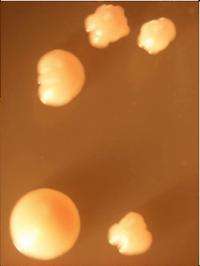A yeast cancer model for mapping cancer genes

Researchers have devised a scheme for identifying genes in yeast that could lead to the identification of new cancer genes in humans. The study is published online this week in the open-access journal PLoS Biology.
Cancers arise from the accumulation of mutations or genetic alterations resulting in the uncontrolled proliferation of cells. However, the number of mutations accumulated during the evolution of cancerous cells is large, making it difficult to identify which of the mutations are responsible for the cancer phenotypes. Identifying new genes that sustain cancerous growth is a major challenge in the campaign against cancers.
Aneuploidy, an abnormality in chromosome number and structure, is a hallmark of many cancer cells. One idea is that aneuploidy may cause cancer by changing the dosage or expression of oncogenes (cancer-causing genes). After decades of research, only a handful of human oncogenes have been identified, accounting for a tiny fraction of all cancers So methods of identifying new oncogenes through their association with aneuploidy has become an accepted strategy in the cancer field.
The Mcm4Chaos3 mutation causes a defect in an enzyme that unwinds DNA during DNA replication and predisposes mice to mammary tumors. In this study, a team led by Bik Tye from Cornell University introduced the equivalent mutation in yeast. Yeast with this mutation generate chromosomal abnormalities and yield faster growing progeny, a situation reminiscent of what happens in tumors. Using the yeast genetics tools the researchers could show that improved growth is not linked to aneuploidy, but to point mutations in just a few genetic loci.
Pathways and genes that regulate proliferation rates are likely to be conserved in all eukaryotes. So, by identifying mutations that give cells a growth advantage in yeast, the simplest of eukaryotes, will help guide the search of cancer genes in humans.
More information: Li XC, Schimenti JC, Tye BK (2009) Aneuploidy and Improved Growth Are Coincident but Not Causal in a Yeast Cancer Model. PLoS Biol 7(7): e1000161.doi:10.1371/journal.pbio.1000161
Source: Public Library of Science (news : web)
















